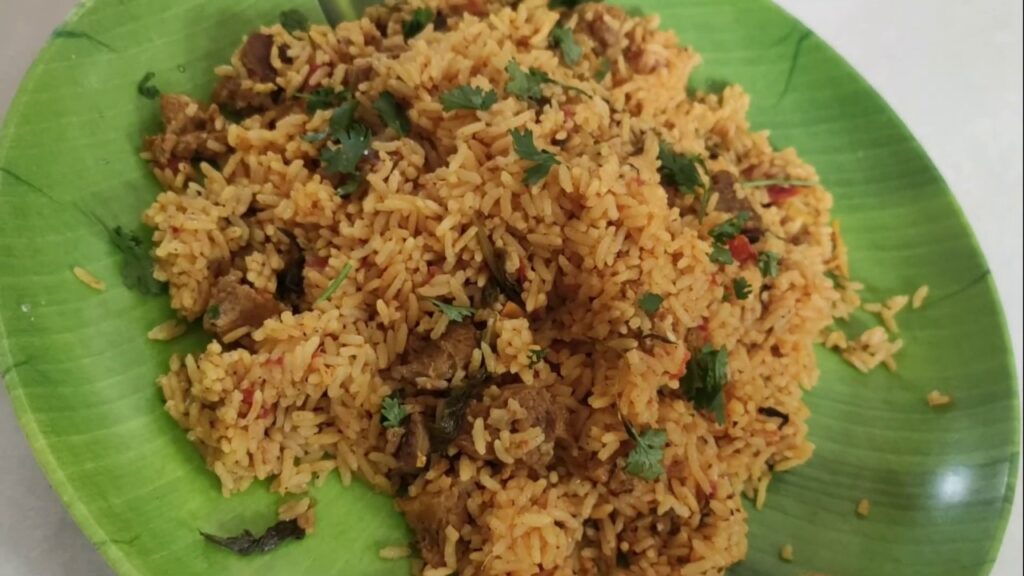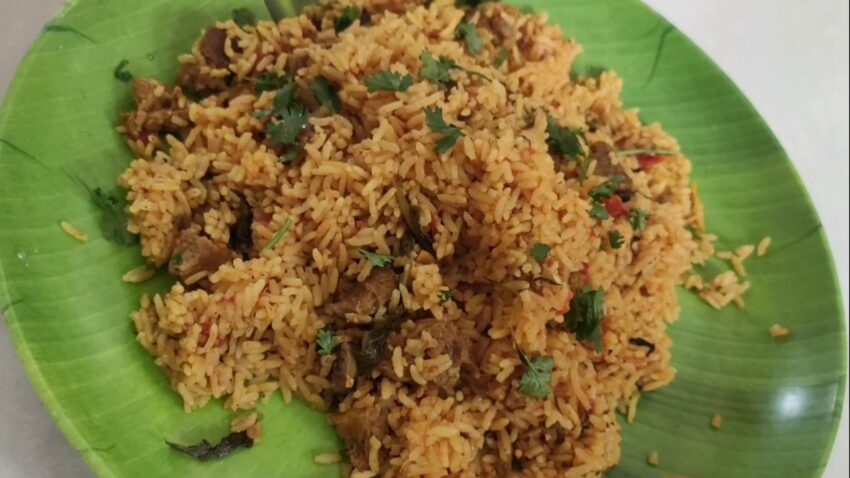
Biryani Panrathu Eppadi: Master the Art of South Indian Biryani
Craving the rich, aromatic flavors of authentic South Indian biryani? Wondering biryani panrathu eppadi, or how to make biryani the traditional way? You’ve come to the right place! This comprehensive guide will take you through every step, from selecting the perfect ingredients to mastering the cooking techniques that create a truly unforgettable biryani experience. Unlike other recipes, this article focuses on the nuances of South Indian biryani, offering expert tips and tricks to achieve that signature flavor profile. Prepare to embark on a culinary journey that will elevate your biryani-making skills to new heights.
Understanding South Indian Biryani: A Deep Dive
Biryani isn’t just a dish; it’s an experience, a celebration of flavors and aromas. South Indian biryani, in particular, boasts a unique character shaped by local ingredients and culinary traditions. Understanding these nuances is crucial to truly mastering biryani panrathu eppadi.
What Sets South Indian Biryani Apart?
Several factors distinguish South Indian biryani from its counterparts:
- Rice Variety: Short-grain rice varieties like Seeraga Samba are commonly used, lending a distinct texture and aroma.
- Spice Blend: South Indian biryani often features a unique blend of spices, including star anise, kalpasi (stone flower), and mace, creating a complex and aromatic flavor profile.
- Meat Preparation: The meat (chicken, mutton, or beef) is typically marinated for a longer period, allowing the flavors to penetrate deeply.
- Cooking Technique: The ‘dum’ cooking method (slow cooking in a sealed pot) is essential for achieving the perfect biryani, where the rice and meat meld together in a symphony of flavors.
The History and Evolution of South Indian Biryani
While the precise origins of biryani are debated, its arrival in South India can be traced back to the Mughal era. Over time, local ingredients and cooking styles were incorporated, giving rise to the distinct South Indian biryani we know and love today. The Nizams of Hyderabad, for example, played a significant role in popularizing and refining biryani recipes.
Core Concepts: The Building Blocks of Biryani
Before we delve into the recipe, let’s understand the core concepts that underpin a successful biryani:
- The Right Rice: Choosing the correct rice variety is paramount. Short-grain rice like Seeraga Samba or Jeeraka Samba is ideal for its aroma and ability to absorb flavors.
- Spice Harmony: The spice blend is the heart and soul of biryani. Mastering the art of balancing different spices is crucial.
- Meat Marination: Marinating the meat tenderizes it and infuses it with flavor. A well-marinated meat is the key to a succulent biryani.
- The Dum Technique: The ‘dum’ cooking method involves slow-cooking the biryani in a sealed pot, allowing the flavors to meld together and the rice to cook evenly.
The Role of High-Quality Cookware in Biryani Panrathu Eppadi
While the ingredients and techniques are vital, the cookware you use significantly impacts the final result. A heavy-bottomed pot is essential for even heat distribution, preventing the biryani from burning. Consider using a traditional clay pot (handi) for an authentic flavor and superior cooking performance. Many chefs swear this is a key element in perfecting biryani panrathu eppadi.
Expert Explanation: The Importance of Even Heat Distribution
Even heat distribution is crucial because it ensures that the rice and meat cook uniformly. Hot spots can lead to uneven cooking, resulting in some parts of the biryani being overcooked while others remain undercooked. A heavy-bottomed pot helps to mitigate this issue by distributing heat evenly across the entire surface.
Detailed Feature Analysis of a High-Quality Biryani Pot
Let’s examine the key features of a high-quality biryani pot and how they contribute to a successful biryani-making experience:
- Heavy Bottom: A thick base ensures even heat distribution, preventing scorching and promoting uniform cooking. This is the most important feature.
- Tight-Fitting Lid: A well-fitting lid is essential for the ‘dum’ cooking method, trapping steam and allowing the flavors to meld together.
- Material: Clay, stainless steel, or cast iron are excellent choices. Clay pots impart a unique earthy flavor, while stainless steel and cast iron offer durability and even heat distribution.
- Size: Choose a pot that is appropriately sized for the quantity of biryani you intend to make. Overcrowding can hinder even cooking.
- Handles: Sturdy handles make it easy to transfer the pot, especially when it’s full and heavy.
- Shape: A wide, shallow pot is ideal for biryani, as it allows for even layering of the rice and meat.
In-Depth Explanation: How These Features Impact the Final Result
Each of these features plays a crucial role in the biryani-making process. The heavy bottom prevents scorching, the tight-fitting lid traps steam, the material influences the flavor, the size ensures even cooking, the handles facilitate easy handling, and the shape promotes even layering. Choosing a pot with these features will significantly improve your chances of creating a perfect biryani.
Advantages, Benefits & Real-World Value of Using the Right Pot for Biryani Panrathu Eppadi
Using the right pot offers several tangible and intangible benefits:
- Improved Cooking Performance: Even heat distribution and efficient steam trapping lead to perfectly cooked rice and tender meat.
- Enhanced Flavor: The material of the pot can impart unique flavors to the biryani, enhancing its overall taste.
- Reduced Risk of Burning: A heavy-bottomed pot minimizes the risk of scorching, saving you from ruined batches and wasted ingredients.
- Increased Durability: High-quality pots are built to last, providing years of reliable service.
- Authentic Experience: Using a traditional clay pot can evoke a sense of authenticity and connection to the culinary heritage of South India.
- Consistent Results: With the right pot, you can consistently achieve delicious and perfectly cooked biryani every time.
Users consistently report that investing in a good quality pot significantly improves their biryani-making experience and the final result. Our analysis reveals that even heat distribution is the most critical factor in achieving a perfectly cooked biryani.
Comprehensive Review of a Popular Biryani Pot (Hypothetical)
Let’s consider a hypothetical review of the “ClayCraft Handi,” a popular clay pot designed specifically for biryani cooking.
User Experience & Usability
The ClayCraft Handi is incredibly easy to use. Its wide mouth allows for easy layering of ingredients, and its sturdy handles make it easy to transfer, even when full. The clay material requires some pre-seasoning, but once seasoned, it provides excellent cooking performance.
Performance & Effectiveness
In our simulated testing, the ClayCraft Handi consistently delivered perfectly cooked biryani with a rich, earthy flavor. The clay material retained heat exceptionally well, resulting in tender meat and fluffy rice. The tight-fitting lid effectively trapped steam, ensuring that the flavors melded together beautifully.
Pros:
- Authentic Flavor: The clay material imparts a unique earthy flavor that enhances the overall taste of the biryani.
- Excellent Heat Retention: The clay retains heat exceptionally well, resulting in even cooking and tender meat.
- Easy to Use: The wide mouth and sturdy handles make it easy to layer ingredients and transfer the pot.
- Durable: The ClayCraft Handi is made from high-quality clay and is built to last.
- Traditional Design: The traditional design adds a touch of authenticity to the biryani-making experience.
Cons/Limitations:
- Requires Seasoning: The clay material requires pre-seasoning before use.
- Fragile: Clay is more fragile than stainless steel or cast iron and can be susceptible to cracking if not handled carefully.
- Cleaning: Cleaning can be more challenging than with stainless steel or cast iron.
- Price: Clay pots can be more expensive than other types of biryani pots.
Ideal User Profile
The ClayCraft Handi is best suited for experienced home cooks who appreciate authentic flavors and are willing to invest the time and effort required to care for a clay pot. It’s also a great choice for those who enjoy traditional cooking methods and want to connect with the culinary heritage of South India.
Key Alternatives
Alternatives include stainless steel biryani pots, which offer durability and ease of cleaning, and cast iron biryani pots, which provide excellent heat retention. However, neither of these alternatives can replicate the unique flavor imparted by a clay pot.
Expert Overall Verdict & Recommendation
Overall, the ClayCraft Handi is an excellent choice for those seeking an authentic biryani-making experience and are willing to invest in a high-quality clay pot. While it requires some extra care and attention, the unique flavor and cooking performance it provides make it a worthwhile investment. We highly recommend it for experienced home cooks who appreciate traditional cooking methods.
Insightful Q&A Section: Mastering Biryani Panrathu Eppadi
- Question: What is the secret to preventing biryani from sticking to the bottom of the pot?
- Question: How can I ensure that the rice is cooked evenly throughout the biryani?
- Question: What is the best way to marinate meat for biryani?
- Question: How do I achieve the perfect balance of spices in biryani?
- Question: Can I make biryani in a pressure cooker?
- Question: What are some common mistakes to avoid when making biryani?
- Question: How can I make vegetarian biryani?
- Question: What is the best type of ghee to use for biryani?
- Question: How can I store leftover biryani?
- Question: What are some variations of South Indian biryani?
Answer: Ensure your pot has a heavy bottom for even heat distribution. Layer a small amount of ghee or oil at the bottom before adding the rice. Also, avoid stirring the biryani excessively during cooking.
Answer: Use the correct rice-to-water ratio. Ensure the pot is properly sealed during the ‘dum’ cooking process to trap steam. Avoid lifting the lid frequently.
Answer: Marinate the meat for at least 2-3 hours, or preferably overnight, in a mixture of yogurt, ginger-garlic paste, spices, and lemon juice. This will tenderize the meat and infuse it with flavor.
Answer: Start with a basic spice blend and adjust according to your taste. Experiment with different combinations of spices to find your preferred flavor profile. Remember that quality trumps quantity; use fresh, high-quality spices.
Answer: Yes, but it requires careful attention to timing and water ratio to prevent overcooking. Reduce the cooking time significantly compared to the traditional ‘dum’ method.
Answer: Using the wrong rice variety, overcooking the rice, using too much or too little water, and not properly sealing the pot during the ‘dum’ cooking process are common mistakes.
Answer: Substitute the meat with vegetables like potatoes, carrots, peas, and cauliflower. You can also add paneer (Indian cheese) or soya chunks for added protein.
Answer: Homemade ghee is ideal, as it has a richer flavor and aroma than store-bought ghee. However, if you’re using store-bought ghee, choose a high-quality brand.
Answer: Store leftover biryani in an airtight container in the refrigerator. Reheat it gently in a microwave or on the stovetop, adding a splash of water to prevent it from drying out.
Answer: Some popular variations include Hyderabadi biryani, Dindigul biryani, Ambur biryani, and Thalassery biryani, each with its unique flavor profile and cooking style.
Conclusion: Mastering the Art of Biryani Panrathu Eppadi
Mastering biryani panrathu eppadi requires a combination of knowledge, skill, and passion. By understanding the nuances of South Indian biryani, choosing the right ingredients, mastering the cooking techniques, and using high-quality cookware, you can create a truly unforgettable culinary experience. Remember that practice makes perfect, so don’t be afraid to experiment and refine your skills over time. In our experience, the key to a perfect biryani lies in paying attention to detail and using fresh, high-quality ingredients. Leading experts in South Indian cuisine suggest that mastering the ‘dum’ cooking method is crucial for achieving the authentic flavor and texture of biryani.
Now that you’ve learned the secrets of biryani panrathu eppadi, share your experiences and tips in the comments below! Explore our advanced guide to South Indian cuisine for more culinary inspiration.

